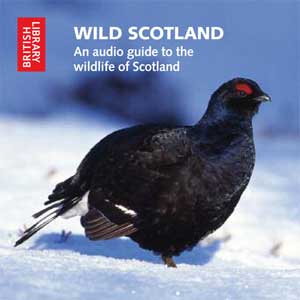Cheryl Tipp, Natural Sounds curator writes:
Can't tell your Capercaillie from your Ptarmigan? Then the British Library might be able to help. The latest title in the Library's series of wildlife & environmental audio publications, Wild Scotland, brings together the vocalisations of 30 species commonly found in this part of the world.
Several species, such as the Black-throated
Diver, Crested Tit, Corncrake, Capercaillie and Pine Marten can only be found
in Scotland, being absent from the rest of Britain. The Crested Tit, for
example, is a highly specialised bird that is mainly restricted to the ancient
Caledonian pine forests and Scot’s pine plantations of the Highlands.
Likewise, the Capercaillie, a large woodland grouse that can reach almost a
metre in height, is only found in the remnants of these once widespread and now
vulnerable native pine forests. The Black-throated Diver, with its mournful,
wailing song, only breeds in the northwest of the country, as does the secretive
Corncrake. The distinctive ‘crex crex’ song of this member of the Rail family
was once a familiar sound among the grasslands of Britain and much of Ireland,
but changes in agricultural practices led to a dramatic population decline.
Today, the Corncrake is mainly found on Orkney and the Hebrides,
but conservation efforts are afoot to expand the geographical range of this
bird.

One of the most evocative images
of Scotland is that of the Red Deer stag. This
‘monarch of the glen’ is a powerful symbol of the Scottish wildness and its
bellowing roars during the annual rut are no less impressive. Another
longstanding symbol of the Scottish wilderness is that of a Golden Eagle
soaring over the barren moorlands and rugged mountainous ranges in search of
prey. The Golden Eagle is one of Britain’s
largest birds of prey and its breeding territory lies mainly in the Scottish Highlands and islands. Although mostly
silent, it can be identified by its strong, yelping call. Other key species may
be smaller in stature but are just as characteristic of Scotland’s wild
places. The Red Squirrel is Britain’s
only native squirrel species with around 75% of the UK
population occurring in Scotland.
This is due in part to some areas remaining free from the invasive Grey
Squirrel, which has been responsible for Red Squirrel declines in other parts
of Britain.
The Pine Marten, though elusive and difficult to spot due to its nocturnal
nature, has its stronghold in the woodlands of Scotland and is finally on the road
to recovery after suffering significant persecution during the 19th
century.
The majority of the recordings
featured on this disc were recorded on location in various parts of Scotland. The
remaining examples were recorded in England and were selected on the
basis of superior audio quality or required vocalisation type. Despite being
recorded in another country, all are accurate depictions of calls produced by
their Scottish cousins.
Wild Scotland is designed to act both
as an identification guide and an audio celebration of the many natural sounds
of the country’s diverse and glorious habitats. Whether you are an armchair
traveller or preparing for a holiday, this collection of field recordings showcases
some of the marvellous wildlife that can be experienced in this inspiring land.
(Wild Scotland is available from the British Library shop priced at £10.00)